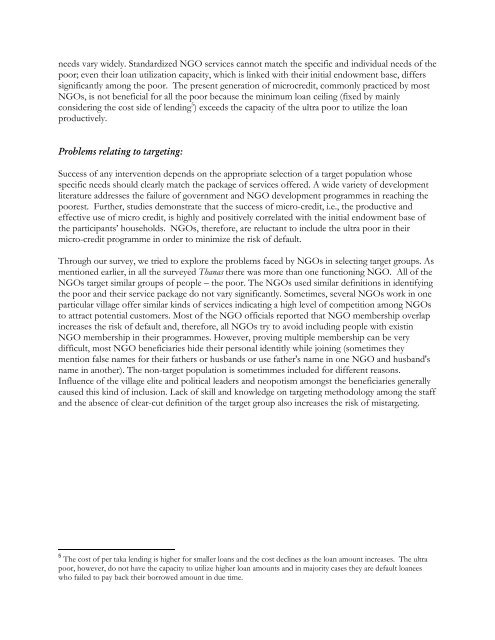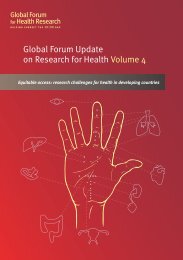Draft for comments only Reviewing existing NGO services for the ...
Draft for comments only Reviewing existing NGO services for the ...
Draft for comments only Reviewing existing NGO services for the ...
Create successful ePaper yourself
Turn your PDF publications into a flip-book with our unique Google optimized e-Paper software.
needs vary widely. Standardized <strong>NGO</strong> <strong>services</strong> cannot match <strong>the</strong> specific and individual needs of <strong>the</strong><br />
poor; even <strong>the</strong>ir loan utilization capacity, which is linked with <strong>the</strong>ir initial endowment base, differs<br />
significantly among <strong>the</strong> poor. The present generation of microcredit, comm<strong>only</strong> practiced by most<br />
<strong>NGO</strong>s, is not beneficial <strong>for</strong> all <strong>the</strong> poor because <strong>the</strong> minimum loan ceiling (fixed by mainly<br />
considering <strong>the</strong> cost side of lending 5 ) exceeds <strong>the</strong> capacity of <strong>the</strong> ultra poor to utilize <strong>the</strong> loan<br />
productively.<br />
Problems relating to targeting:<br />
Success of any intervention depends on <strong>the</strong> appropriate selection of a target population whose<br />
specific needs should clearly match <strong>the</strong> package of <strong>services</strong> offered. A wide variety of development<br />
literature addresses <strong>the</strong> failure of government and <strong>NGO</strong> development programmes in reaching <strong>the</strong><br />
poorest. Fur<strong>the</strong>r, studies demonstrate that <strong>the</strong> success of micro-credit, i.e., <strong>the</strong> productive and<br />
effective use of micro credit, is highly and positively correlated with <strong>the</strong> initial endowment base of<br />
<strong>the</strong> participants’ households. <strong>NGO</strong>s, <strong>the</strong>re<strong>for</strong>e, are reluctant to include <strong>the</strong> ultra poor in <strong>the</strong>ir<br />
micro-credit programme in order to minimize <strong>the</strong> risk of default.<br />
Through our survey, we tried to explore <strong>the</strong> problems faced by <strong>NGO</strong>s in selecting target groups. As<br />
mentioned earlier, in all <strong>the</strong> surveyed Thanas <strong>the</strong>re was more than one functioning <strong>NGO</strong>. All of <strong>the</strong><br />
<strong>NGO</strong>s target similar groups of people – <strong>the</strong> poor. The <strong>NGO</strong>s used similar definitions in identifying<br />
<strong>the</strong> poor and <strong>the</strong>ir service package do not vary significantly. Sometimes, several <strong>NGO</strong>s work in one<br />
particular village offer similar kinds of <strong>services</strong> indicating a high level of competition among <strong>NGO</strong>s<br />
to attract potential customers. Most of <strong>the</strong> <strong>NGO</strong> officials reported that <strong>NGO</strong> membership overlap<br />
increases <strong>the</strong> risk of default and, <strong>the</strong>re<strong>for</strong>e, all <strong>NGO</strong>s try to avoid including people with existin<br />
<strong>NGO</strong> membership in <strong>the</strong>ir programmes. However, proving multiple membership can be very<br />
difficult, most <strong>NGO</strong> beneficiaries hide <strong>the</strong>ir personal identitly while joining (sometimes <strong>the</strong>y<br />
mention false names <strong>for</strong> <strong>the</strong>ir fa<strong>the</strong>rs or husbands or use fa<strong>the</strong>r's name in one <strong>NGO</strong> and husband's<br />
name in ano<strong>the</strong>r). The non-target population is sometimmes included <strong>for</strong> different reasons.<br />
Influence of <strong>the</strong> village elite and political leaders and neopotism amongst <strong>the</strong> beneficiaries generally<br />
caused this kind of inclusion. Lack of skill and knowledge on targeting methodology among <strong>the</strong> staff<br />
and <strong>the</strong> absence of clear-cut definition of <strong>the</strong> target group also increases <strong>the</strong> risk of mistargeting.<br />
5 The cost of per taka lending is higher <strong>for</strong> smaller loans and <strong>the</strong> cost declines as <strong>the</strong> loan amount increases. The ultra<br />
poor, however, do not have <strong>the</strong> capacity to utilize higher loan amounts and in majority cases <strong>the</strong>y are default loanees<br />
who failed to pay back <strong>the</strong>ir borrowed amount in due time.
















![[re-tender] RFQ for supply of Diesel Generator - Brac](https://img.yumpu.com/44421374/1/186x260/re-tender-rfq-for-supply-of-diesel-generator-brac.jpg?quality=85)
